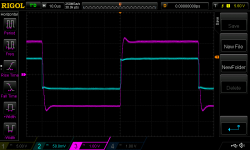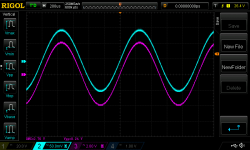Thank you Kean
I allready listened to the amp connected to several preamps.
It works perfectly with your superbuffer, it works also very well with salas dcb1 but it distorts heavily at medium output with salas new high current preamp.
Can the output impedance of the preamp affect distortion ?
I allready listened to the amp connected to several preamps.
It works perfectly with your superbuffer, it works also very well with salas dcb1 but it distorts heavily at medium output with salas new high current preamp.
Can the output impedance of the preamp affect distortion ?
hi, i am still bothered by two things.
1. the emitter of the current mirror loads ought to be equal fixed value resistors.
2. the 1000ufd series cap the 820 ohm shunt leg of the feedback network,
a 220 ufd would have been more than enough...
1. the emitter of the current mirror loads ought to be equal fixed value resistors.
2. the 1000ufd series cap the 820 ohm shunt leg of the feedback network,
a 220 ufd would have been more than enough...
Will replace the mirror load resistors by fixed ones.
How does the 1000u affect distortion ?
one of the N mosfets is drawing much less current than the others... another issue to solve now
How does the 1000u affect distortion ?
one of the N mosfets is drawing much less current than the others... another issue to solve now
bigger than usual affects recovery from overloads,
820 ohms + 1000 ufd gives you a corner freq of 0.1941898400Hz
820 ohms + 220 ufd gives you a corner freq of 0.8826810909Hz
820 ohms + 100 ufd gives you a corner freq of 1.941898400Hz
820 ohms + 47 ufd gives you a corner freq of 4.1316987231398 Hz
820 ohms + 1000 ufd gives you a corner freq of 0.1941898400Hz
820 ohms + 220 ufd gives you a corner freq of 0.8826810909Hz
820 ohms + 100 ufd gives you a corner freq of 1.941898400Hz
820 ohms + 47 ufd gives you a corner freq of 4.1316987231398 Hz
On an FET amp like this, source impedance shouldn't be a problem, unless it pushes the input stage into oscillation, which is sometimes the case with FETs.
Bass is promissing but trebble is gritty and this is more noticeable at high volumes.
I have distorted squares at 40khz so I believe I have oscilations in the input stage.
Will try a different voltage reference in the ltp cascodes now
I have distorted squares at 40khz so I believe I have oscilations in the input stage.
Will try a different voltage reference in the ltp cascodes now
I now connected the voltage divider that serves as vref for the ltp cascode to signal gnd instead of the sources of the jfets.
During power on, initial voltage rise at the output is now limited to 1.5V (before I registered power on voltages around 30V).
Offset settles at 2mV after 30 min (it follows temperature)
Now I do not have the serious distortion previously seen at 40khz but there is an initial rise in the square, seen at all frequencies.
What should be the cause of this ?
During power on, initial voltage rise at the output is now limited to 1.5V (before I registered power on voltages around 30V).
Offset settles at 2mV after 30 min (it follows temperature)
Now I do not have the serious distortion previously seen at 40khz but there is an initial rise in the square, seen at all frequencies.
What should be the cause of this ?
Attachments
Sounds slightly cleaner now but it "crackles" when I push the volume up to medium.
Allready increased input series resistance to 2k7 and it did not solve the issue.
It seems to overload to easily... gain is now 32dB with the feedback resistors 33k and 820 ohm.... should I increase feedback to lower gain ?
Allready increased input series resistance to 2k7 and it did not solve the issue.
It seems to overload to easily... gain is now 32dB with the feedback resistors 33k and 820 ohm.... should I increase feedback to lower gain ?
33k and 820
values that i frequently use....
how much cap is in series with the 820 ohms? even a 47 ufd cap will work fine...
you can tweak the VAS current increasing it slightly till you get it right to your ears...
or no traces of cross over distortions can be seen on the scope at 1 watt output levels...
also if you are using emitter followers to drive mosfet gates,
you probably need more current to speed up discharging gate mosfet capacitance
during turn off...
what is the 1khz sine wave look like at 2.6v ac output into 8 ohm loads in your scope?
It looks like a sine without distortion
It looks like a sine without distortion
good, this is one of those things you want to check in a newly powered amp...
check and watch out that no drivers and outputs are overheating.....
what is the sine look like at onset of clipping?
what is the sine look like at onset of clipping?
It clips at 37Vrms with 1.5V input at 20khz... seems correct in the bench.
Why should it "crackle" when listening to music at moderate levels ?
Why should it "crackle" when listening to music at moderate levels ?
"crackle" can be caused by many things like loose connections at the speakers or pcb cold solder....
hard to troubleshoot this one in front of the computer monitor.....
hard to troubleshoot this one in front of the computer monitor.....
- Status
- Not open for further replies.
- Home
- Amplifiers
- Solid State
- Very HQ power amplifier (Assemblage VII)

